Home » What is ERP? A Comprehensive Guide
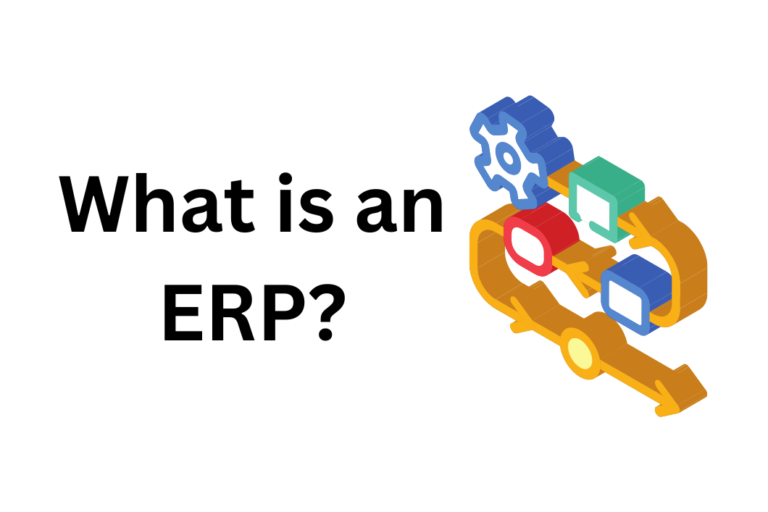
As a service provider of ERP systems, we know how important these systems are for making operations smoother, improving decision-making, and boosting business growth. This guide covers the basics of ERP, including deployment options, benefits, implementation strategies, best practices, and future trends. Whether you’re a small business or a large enterprise, this guide will help you understand ERP and make informed decisions. It offers valuable insights for organizations thinking about using ERP systems or already using them. So let’s get started with the main question: what is exactly an ERP?
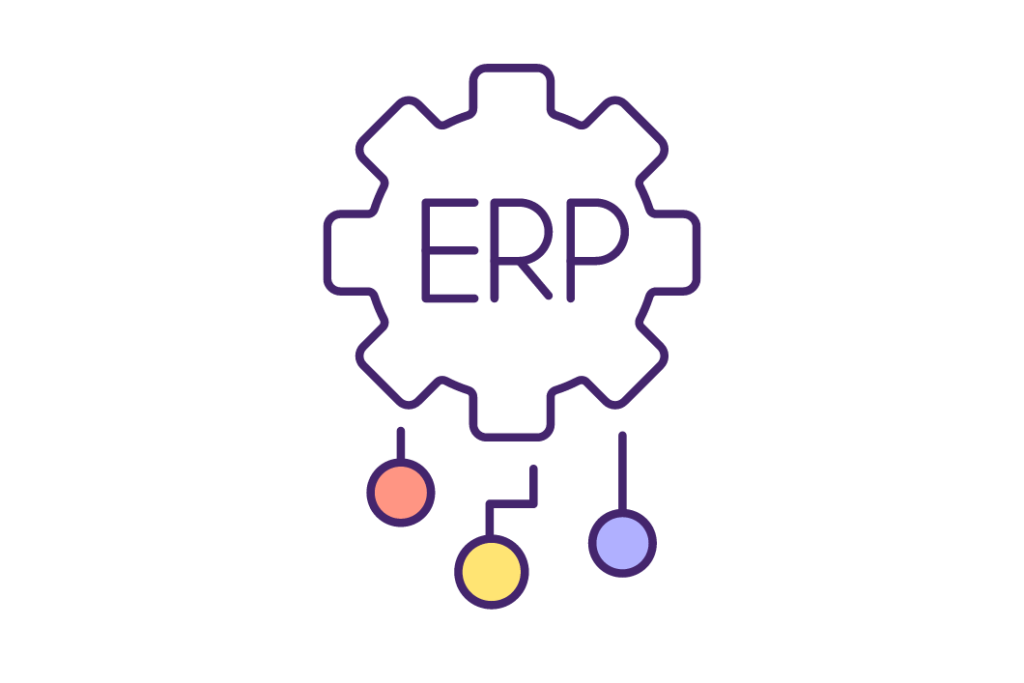
An Enterprise Resource Planning (ERP) system is a set of software used by organizations to manage and integrate the important parts of their businesses. It integrates various organizational departments and their functions into one complete system, such as accounting, supply chain management, customer relationship management, and human resources. The term ‘ERP system‘ emphasizes the entire suite of ERP software applications. It represents the holistic integration of all ERP software modules within an organization, ensuring that all business processes and data are interconnected. This integration helps in eliminating data silos, reducing manual data entry, and providing a single source of truth for the entire organization.
Thats about ERP system but are there any ERP software? well, ERP software refers specifically to the individual applications or modules within the ERP system. These software modules are designed to handle specific business functions. For example, there might be ERP software for managing financials, another for inventory management, and yet another for human resources. Each software module can work independently, but when integrated into an ERP system, they share a common database, allowing for consistent and real-time data across all departments.
As we have learned about both ERP systems and ERP software. Let’s see the Types or deploment options for ERPs:
When implementing an ERP system, organizations have three main deployment options: on-premises, cloud-based or hybrid.
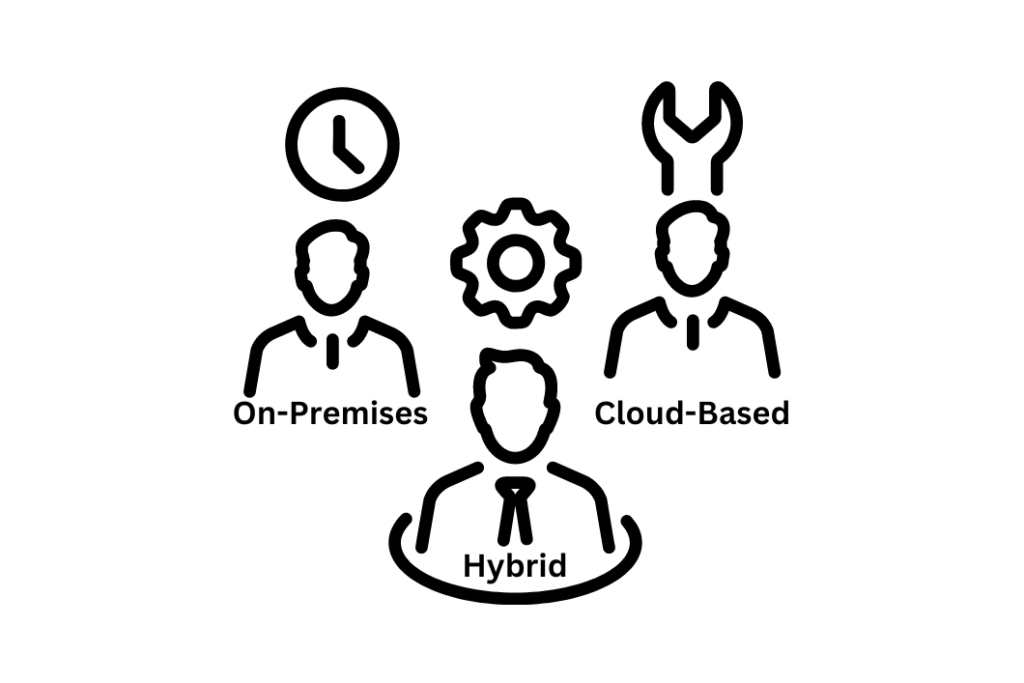
On-premises ERP involves installing and maintaining the ERP software and associated hardware within the organization’s own data center or IT environment. This approach gives more control, customization options, and better data security and compliance measures. However, it requires significant upfront capital investment in hardware, software licenses, and IT resources for installation and maintenance. Organizations are responsible for managing software updates, patches, and backups, which can be time-consuming and resource-intensive.
Cloud-based ERP solutions, also known as Software as a Service (SaaS) ERP, are hosted by the vendor on their servers and accessed online. This deployment model offers several advantages, including lower upfront costs, scalability, and easier maintenance and updates. Organizations can access the software and data from anywhere with an internet connection, enabling remote access and collaboration. The vendor manages infrastructure, updates, and security, which saves internal IT resources. However, potential concerns related to data privacy, compliance requirements, and internet connectivity must be considered.
A hybrid deployment combines features of both on-premises and cloud-based ERP solutions. Organizations may choose to keep certain critical functions on-premises while utilizing cloud-based services for other parts of their ERP system. This approach provides flexibility and lets organizations to enjoy the advantages of both deployment methods. For example, organizations may opt for on-premises deployment for sensitive data or specific customizations while using cloud-based deployment for scalability and accessibility.
The choice between on-premises, cloud-based, and hybrid deployment depends on several factors such as an organization’s specific requirements, budget, IT infrastructure, and long-term strategic goals. Each deployment option has its own set of advantages and considerations, and organizations must carefully calculate and evaluate their needs to determine the most suitable option for their business.
After the types or deployment options of ERP systems, let’s get to the benefits an organization can have with an ERP.
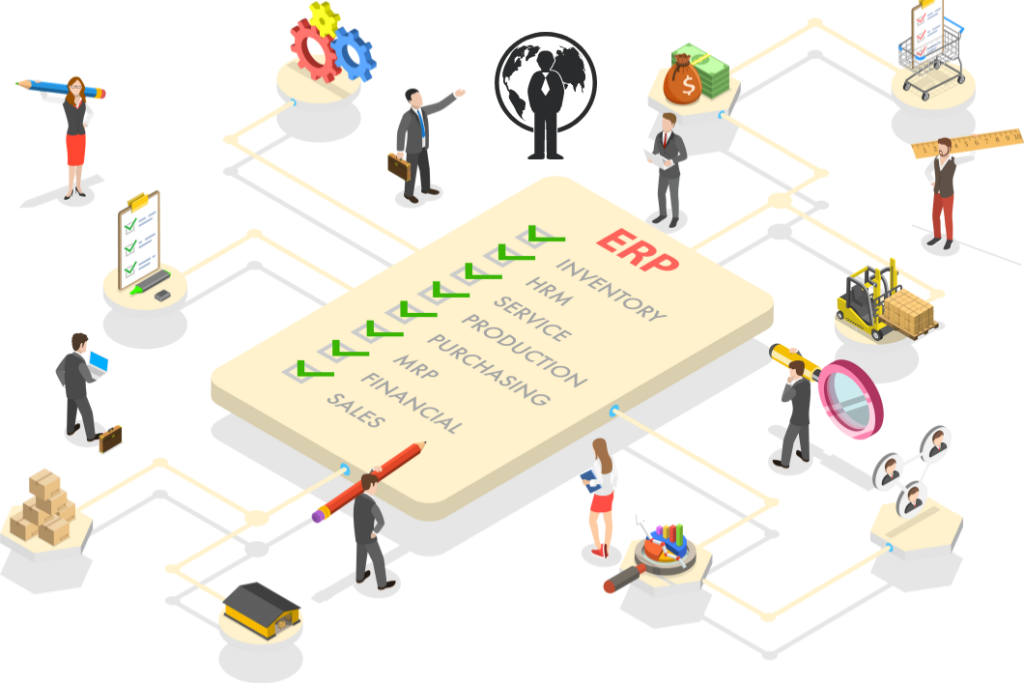
Implementing an ERP system has many advantages and is often a turning point for many organizations. Primarily, it enables organizations to streamline operations, enhance decision-making, and drive business growth. Here are some key advantages:
ERP streamlines business processes by standardizing them across departments. This consistency ensures that everyone follows the same procedures, reducing confusion and improving overall efficiency. For example, an ERP system can enforce standardized approval processes for purchase orders or automate the routing of invoices for payment.
ERP improves operational efficiency by automating manual tasks and integrating disparate processes across same or different departments. For example, tasks that were once time-consuming, such as data entry or inventory management, can now be automated within the ERP system. This automation not only saves time but also reduces the likelihood of errors that can occur with manual work.
ERP systems provide a centralized database that enables real-time access to information across the organization. This means that employees no longer have to search through multiple systems or spreadsheets to find the data they need. Instead, they can access up-to-date information quickly, enabling faster decision-making and more efficient workflows. This capability facilitates better decision-making and enables businesses to respond quickly to changing market conditions or customer demands.
Real-time data access empowers teams with immediate access to up-to-date information, ensuring that all team members have access to the same accurate data. This fosters better collaboration and communication among team members, promoting alignment and efficiency across the organization. For example, sales teams can instantly access inventory levels to provide accurate delivery estimates to customers, while production teams can adjust manufacturing schedules based on real-time demand data.
ERP systems often have powerful built-in reporting and analytics tools with advanced data visualization, trend analysis, and predictive modeling, empowering organizations to extract valuable insights from their data. With ERP systems, organizations can also generate customized reports that combine real-time data from various departments and processes, providing a holistic view of business operations. This enables users to create dynamic and interactive reports customized to specific needs and requirements, allowing decision-makers to analyze trends, identify opportunities, and make informed decisions.
Furthermore, organizations can automate the reporting process with ERP systems, reducing the time and effort required to generate reports manually. Reports can be scheduled to run automatically at regular intervals, ensuring that stakeholders have access to the latest information without delay.
For organizations involved in Supply Chain Management and manufacturing or distribution, ERP systems can significantly improve supply chain management by providing real-time visibility into inventory levels, optimizing procurement processes, preventing stockouts or excess inventory, optimizing inventory turnover, reducing carrying costs, and enhancing logistics operations.
ERP systems can also automate purchase order generation, supplier management, and invoice processing. This automation not only saves time but also minimizes errors and ensures compliance with procurement policies and regulations. Additionally, ERP systems facilitate better supplier collaboration by providing insights into supplier performance, pricing trends, and contract management.
Furthermore, ERP systems enhance logistics operations by optimizing transportation routes, scheduling deliveries, and managing warehouse operations. Real-time data on inventory levels and customer orders enable organizations to plan and execute logistics activities more effectively, resulting in reduced lead times, improved delivery accuracy, and enhanced customer satisfaction.
These are some of the benefits ERP can provide for organizations. Now, let’s learn about some popular ERPs:
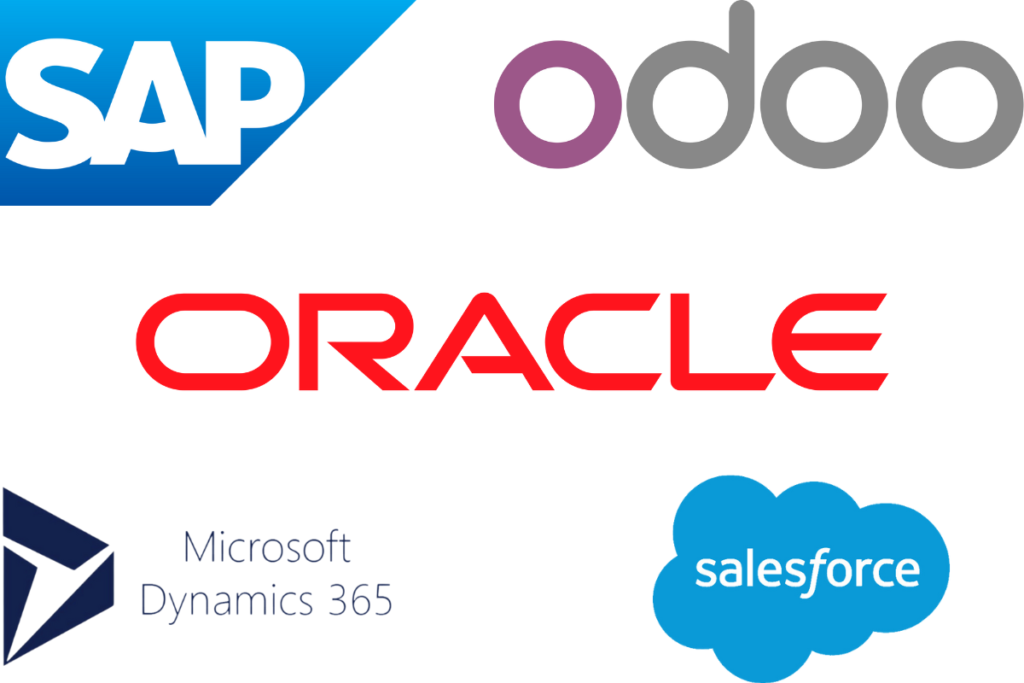
Zoho One, SAP ERP, Oracle ERP Cloud, Microsoft Dynamics 365, NetSuite ERP, Odoo, and Epicor ERP are some of the top ERP systems available today. They help businesses manage their finances, streamline operations, and make better decisions. These systems are used by companies of all sizes, from big corporations to small businesses. Each ERP system has its own features and tools, so companies can choose the one that fits them best. If you wish to read a detailed article on different ERP software read here: Top 6 ERP Software
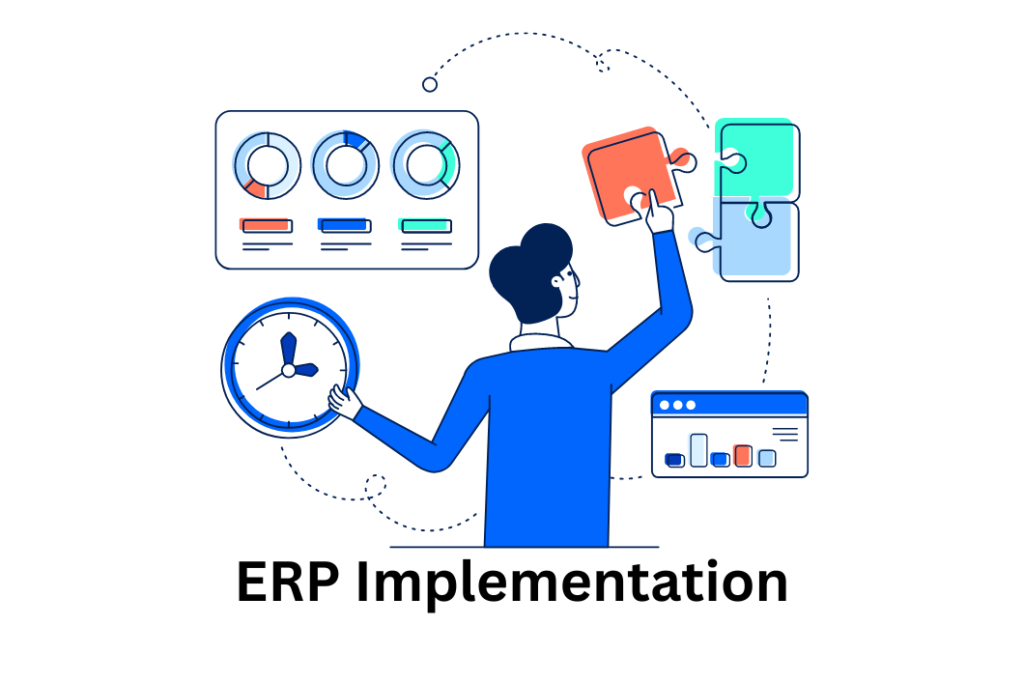
Implementing an ERP properly is crucial for using it effectively. When done right, ERP can bring life-changing results. Implementing an ERP system, like Zoho one, is a complicated process that needs careful planning and execution. Here are the main steps that you may face in the ERP implementation journey:
Before starting an ERP implementation project, it’s important to clearly understand and communicate the organization’s business needs and goals. This may involve conducting a thorough analysis of existing processes, identifying inefficiencies, and determining the specific functionalities and modules required from the ERP system. Engaging stakeholders from various departments and gathering their input with educating them about the update ensures that the ERP system aligns with the overall goals of the organization.
With a clear understanding of business requirements and goals, the next step is to evaluate and select the right ERP solution. This involves researching and comparing different vendors, assessing what they offer, and determining which solution best fits the organization’s needs, budget, and industry-specific requirements. Conducting polls on social media, reviewing case studies, and consulting with industry experts can help in making an informed decision.
After choosing the ERP solution, it’s important to create a detailed plan for its implementation. This plan should include defining project timelines, allocating resources, identifying potential risks and mitigation strategies, and establishing a communication plan to keep stakeholders informed throughout the process.
One of the most important parts of ERP implementation is data migration and integration. This involves transferring existing data from old systems or previous ERP to the new ERP platform, ensuring data integrity, and establishing seamless integration with other business applications or systems. It’s really important to clean and check the data properly to avoid any problems or mistakes during migration.
Before going live with the ERP system, it’s really important to test it carefully and thoroughly. This includes testing individual modules, integration points, and end-to-end processes to identify and resolve any issues or bugs. If any problems or mistakes are found, they need to be fixed. It’s also a good idea to to conduct User Acceptance Testing (UAT) with representatives from the organization to ensure the system meets their requirements.
Testing and user training goes hand in hand with User Acceptance Testing (UAT). Successful ERP implementation relies heavily on user adoption and acceptance. Providing comprehensive training to end-users, addressing their concerns, and effectively managing organizational change effectively are key steps in the implementation process.
After successful testing and validation, the ERP system can be deployed and go live. However, the implementation process doesn’t end there. Providing ongoing support, addressing user queries, and monitoring system performance are crucial in the post-implementation phase. Continuous improvement and optimization based on user feedback and evolving business needs should also be considered.
Throughout the implementation journey, it’s important to maintain open communication with all stakeholders, closely monitor progress, and make necessary adjustments or course corrections as needed. Getting help from experienced partners or consultants like, Zenith Innovations, can also be really helpful, as they can give good advice based on what they know.
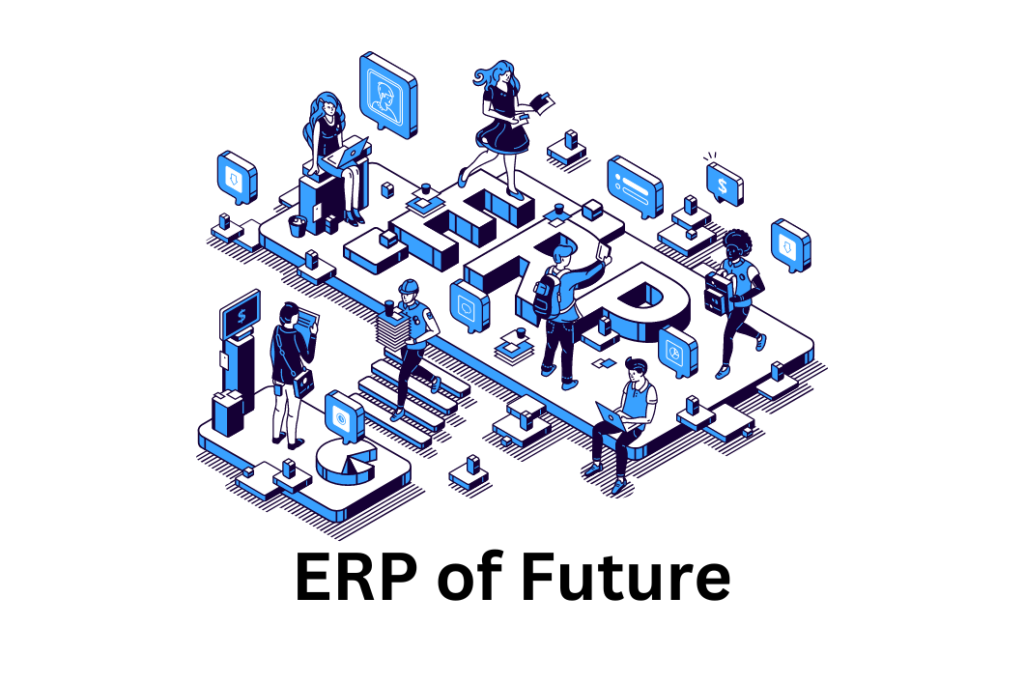
The ERP landscape is constantly evolving due to changing business requirements, supported by rapid advancements in technology. As businesses continue to adapt to a rapidly changing marketplace, ERP vendors are also constantly striving to improve their systems to meet the needs of their customers, driving further advancements in ERP technology. Here are some emerging trends and technologies that are shaping the future of ERP:
The integration of AI and ML into ERP systems is transforming how organizations manage their operations, enabling them to operate more efficiently, adapt to changing conditions, and drive innovation. ERPs are getting smarter with AI and ML. They use these technologies to do things like predicting outcomes, automating tasks, and making data-driven decisions. For example, AI chatbots can answer questions, freeing up manpower for other work. ML algorithms look at big sets of data to find patterns and trends, helping organizations make better decisions and plan for the future. AI-driven predictive maintenance can help organizations optimize asset management and prevent costly downtime by identifying potential issues before they occur.
ERPs can also leverage technological advancements in Internet of Things (IoT). With IoT, devices like sensors and smart machines can connect and share data with each other and with the ERP system. This means ERPs can gather real-time information from machines and equipment, like temperature, pressure, or production rates. This helps businesses make better decisions and respond faster to changes. For example, in manufacturing, IoT sensors can monitor equipment performance and detect issues early, preventing breakdowns and optimizing maintenance schedules. In logistics, IoT devices can track the location and condition of goods in transit, improving inventory management and delivery efficiency. Overall, IoT integration enhances the capabilities of ERP systems by providing a wealth of real-time data for better decision-making and operational efficiency.
ERPs can also utilizes the power of blockchain technology. Blockchain allows for secure, decentralized, and transparent recording of transactions across multiple parties. By integrating blockchain with ERP systems, organizations can ensure the integrity and immutability of their data, enhancing trust and transparency in business processes. For example, in supply chain management, blockchain can be used to track the movement of goods from the point of origin to the final destination, providing a secure and tamper-proof record of each transaction. This helps in verifying the authenticity of products, reducing the risk of fraud, and ensuring compliance with regulatory requirements. Blockchain integration enhances the security, transparency, and efficiency of ERP systems, enabling organizations to operate with greater confidence and trust in their data.
Cloud-based ERP solutions have long been available, but the emergence of cloud-native ERP systems is rapidly gaining traction. These systems are purpose-built for the cloud, utilizing modern architectures and technologies to offer improved scalability, flexibility, and seamless integration with other cloud services. Representing the next generation of ERP systems tailored specifically for cloud environments, cloud-native ERPs stand apart from traditional systems by being built from scratch to leverage the scalability, flexibility, and agility of cloud computing.
Cloud-native ERP systems use modern designs like microservices, containers, and serverless computing to give better performance, resilience, and scalability. These systems offer perks such as quick deployment, automatic scaling, and easy integration with other cloud services. This helps organizations adapt swiftly to changing business needs and market conditions. Additionally, they cut infrastructure costs, simplify management, and boost security, making them attractive for organizations upgrading their ERP systems and driving digital transformation. In summary, cloud-native ERP solutions represent the future of ERP technology, empowering organizations to innovate and compete in today’s fast-paced business world.
Low-code and no-code platforms is another thing making waves in ERP systems. They are enabling organizations to customize and extend their ERP systems without extensive coding or technical expertise. These platforms offer visual interfaces and ready-made templates. Users can create customized solutions by dragging and dropping elements and adjusting settings. With low-code and no-code ERP platforms, businesses can speed up development, lessen reliance on IT teams, and empower non-technical users to create custom apps. Plus, they support quick prototyping and tweaking, helping businesses adapt faster to changing needs.
AR and VR technologies are increasingly being integrated into ERP systems, particularly in areas such as training, remote assistance, and visualizing complex data or processes. They offer immersive experiences and innovative functionalities across various business processes. AR enhances tasks like equipment maintenance and training by overlaying digital information onto the real-world environment. For instance, technicians can utilize AR glasses to view repair instructions while working on machinery. Meanwhile, VR creates entirely virtual environments, which are valuable for simulations and training programs. Employees can participate in virtual training sessions or explore 3D models of products before they’re manufactured. The integration of AR and VR into ERP systems enhances efficiency, reduces errors, and boosts user engagement. As these technologies continue to evolve, they hold the promise of revolutionizing how businesses operate in the digital age.
We hope this post has provided valuable insights into ERP systems and their importance for modern businesses, offering a numerous benefits and adapting to emerging technologies. By understanding deployment options, key advantages, implementation strategies, best practices, and future trends, organizations can make informed decisions and optimize their ERP investments. If you need more help with ERP or want to get started with one, get your free consultation straight away.
Plaza 135, 4th Floor Block-C ,
Civic Center Bahria Town Phase-4 Islamabad
+92 51 6142276
Get Zoho services from the leading firm in Zoho services and Zoho Advanced partner at an unbelievable price and with quality work.